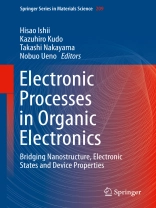The book covers a variety of studies of organic semiconductors, from fundamental electronic states to device applications, including theoretical studies. Furthermore, innovative experimental techniques, e.g., ultrahigh sensitivity photoelectron spectroscopy, photoelectron yield spectroscopy, spin-resolved scanning tunneling microscopy (STM), and a material processing method with optical-vortex and polarization-vortex lasers, are introduced. As this book is intended to serve as a textbook for a graduate level course or as reference material for researchers in organic electronics and nanoscience from electronic states, fundamental science that is necessary to understand the research is described. It does not duplicate the books already written on organic electronics, but focuses mainly on electronic properties that arise from the nature of organic semiconductors (molecular solids). The new experimental methods introduced in this book are applicable to various materials (e.g., metals, inorganic and organic materials). Thus the book is also useful for experts working in physics, chemistry, and related engineering and industrial fields.
विषयसूची
PART I Bridging electronic states and electrical conductivity: Fundamental aspects on organic semiconductors and their interfaces: Experimental electronic structure of organic-device related systems.- Ultraviolet photoelectron spectroscopy (UPS) I: Band dispersion measurements of “Insulating” organic single crystals.- Ultraviolet photoelectron spectroscopy (UPS) II: Electron-phonon coupling and hopping mobility.- Ultraviolet photoelectron spectroscopy (UPS) III: Direct study of “invisible” band gap states by ultrahigh-sensitivity UPS.- Pentacene becomes Mott-Hubbard insulator by potassium doping.- Vertical Bonding Distances Impact Organic-Metal Interface Energetics.- Structure matters: Controlling organic thin film structure and its impact on the energy level alignment at organic interfaces.- Photoelectron yield spectroscopy (PYS) and low energy photoelectron spectroscopy (LE-PES) for organic Materials and interfaces.- PART II Organic devices and their properties: Fabrications and characterization of organic devices.- Carrier transport band in practical polycrystalline organic thin films.- Materials for organic light emitting diode (OLED).- DNA electronics and photonics.- PART III Theoretical study: Theory of photoelectron spectroscopy.- Theoretical aspect of atomic impurity in organic systems.- Numerical approach to charge transport problems on molecular systems.- PART IVBridging different fields – Challenges for the future: Function and Molecular Tiling of Conjugated -Electronic Carbon Walled Nanospaces.- Unique phase behaviors of room-temperature ionic liquids induced by hierarchical ion dynamics.- Single molecular spintronics.- Application of vortex lasers to material processing.











